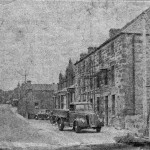The Mill, or (the ‘Mull’ as it is cried in Houpman), was built during 1851 by Mr John Clark as a ‘flour and meal mill’ and it was the largest building in Hopeman being four stories high. Located on Harbour Street, on the north side opposite the park, it was quite a structure in its day containing very superior equipment and machinery including a 22hp steam engine which was relatively new for the North of Scotland and more powerful than the water wheels that provided power for the majority of mills at that time.
Mr John Clark was a fish buyer in Aberdeen and came to Hopeman around 1843 and became the first, and one of the most successful fish curers, in Hopeman. Earlier in life he had been a mason in Edinburgh and having a liking for business he started dealing in fish, flour and other commodities. As his fish curing business in Hopeman expanded he thought he saw an opportunity for a flour mill and set about building these mills after similar works he had seen down south, and as reported in the local newspapers to ”a style of elegance to which extent rather astonished the natives of Hopeman”. It was also reported that “he carried the first stone of the Mills on his back from near the old house at Inverugie, and it is quite well known that every stone required the build the Mills was quarried so close to them that it was not necessary to put them on a cart”. The Mill was built during 1851 and around the same time as the remains of the wooden structure which had carried William Young’s gravity railway from Drummuir Street to Rock House (now demolished with a new house called ‘Rockola’) at the harbour, was removed and replaced by the present earthen embankment which fronted the Mull and carried down on to the harbour. This new road was for a short period of time called Mill Street and is recorded on some birth records of the time.
Within a short period of time the Mills were too heavy a speculation for Mr Clark and he was not really started when he was forced to give up the business. They then came into the ownership of a gentleman called John Robertson who worked them for around a year prior to selling to the Macduff Commercial Company who did a very good job for a number of years. Unfortunately their other trades in commodities such as manures, absorbed all their attention and so they withdrew from the flour department during 1859. The Mills remained idle and during 1862 one of the flats was converted into a grocery shop. By 1867 the property was sold to Mr Christie who intended to remove all of the machinery and convert the building into dwelling houses.
The following are the dates of ownership of the mills
TO BE ADDED
This postcard of a train leaving Hopeman station in 1892 shows the Mill with the pointed roofs behind the station building and the second and third train carriages on the left side. The smaller four storey square block extension housed the steam engine and power plant for the mill whilst the other part (above the third carriage) contained the storage and workings of the mill. The house above the first carriage was called Rock House and is mentioned in the text above.
Gallery
- 1962 – Mill under upgrade
- 2012 -Mill (Lancaster Court) showing road embankment and returning harbour crane



